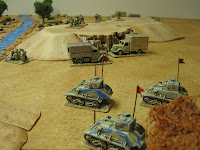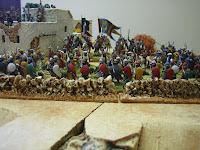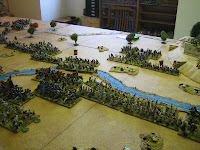

(The above photos are just eye candy and bear no relation to the battle: My pilgrims and Hospitallers and my Arab / Kurdish heavy cavalry - amongst 20 virgin units on the table for The Battle of the River)
The Battle of the River was fought to a conclusion on Wednesday night. Tim was unable to make it so command of the Muslim forces fell to Peter. The battle developed into three distinct and separate fights; so I will deal with each in turn.
The Christian Right
Here, the Christians, in some disarray after the loss of one of their divisional commanders held a line protecting the right flank of the army. Their infantry kept the horse archers at bay whilst falling back at right angles to the main push of the central divisions. The Muslim horse archers, who had dwindled in numbers, were unable to bring any pressure to bear and the action petered out until the Hospitallers charged what remained of the enemy Ghulams; pushing them back onto the river, where they eventually lost heart and departed the field - but they maintained a discipline that honoured their elite status within the army.

.JPG)

The Christian Left
After a sluggish advance the Muslim infantry launched their attack on the hill defended by the Armenian and Maronites. The knights, fearing their infantry would not hold, charged out to do battle and fought a gallant fight against the Turkish Ghazis. These fanatics pushed the knights back from the hill and onto the plain, before, having regained a semblance of order in terrain more to their liking repelled the attack. Their allied infantry did not fare so well, the best of them were pushed back into the village in disorder - the others ran for their lives in the face of the Turkish horde, which for the first time, employed naptha throwers to dislodge the defenders from their wall. But now their advance was halted by fresh westerners, including pilgrims. The result of this battle was to remain unknown - a decision in the centre was about to be achieved.


The Christian Centre
The Christian centre was looking in a precarious position when we left it last week, and in the first part of the evening this position gradually got worse. First the Ghulams shot and charged themselves into a one sided fight with the English sailors, forcing them to withdraw. Now only an Italian contingent stood in their way - but these gallant fellows managed a miraculous stand at the river bank, halting the breakthrough attempt. But the fight was not over. In vain, both sides tried to force a river crossing but each was repulsed. The Christians were about to crack - but the Muslims will was broken first - the Christian infantry had devastated the serried ranks of their enemy with arrow and quarrel volleys.




The game was up! The Muslims, having brought the Christians down to 8 morale points, were now at zero and handing them over to the Christians faster than they could be taken away. Two
Army Morale cards back to back did for them. Their left fell back in disorder and their central divisions broke en-masse. Their right was still fighting on, but their position was now hopeless; relieved, the Christians allowed them to withdraw without pursuit.They had won with 15 morale points remaining.

Conclusion
Yet again the rules worked extremely well. A battle involving 50 units and involving two novice (one virgin) players had been fought to decision in five hours. The game was very tight in the centre. Had the Muslims managed to punch a hole through the Christian line here, they had so much cavalry massed up ready to exploit it that, with the localised victory on their right in their grasp, the tide would certainly have turned.
Next week - The pre-run of the Ilkley Lads WWII game for Vapnartak in York; with visiting figures and armour from Mark D.












































.JPG)
























